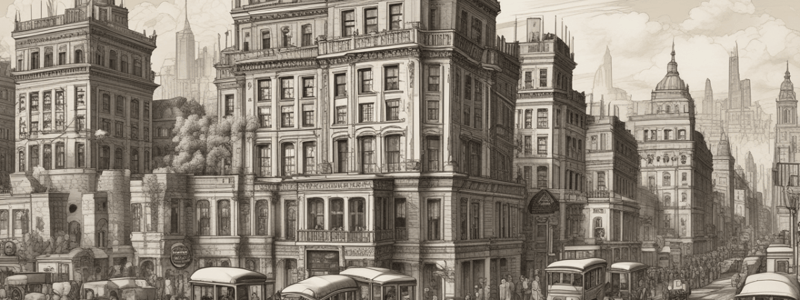Podcast
Questions and Answers
What percentage of Americans lived in a town of 8,000 people or more on the eve of the Civil War?
What percentage of Americans lived in a town of 8,000 people or more on the eve of the Civil War?
- 40%
- 30%
- 20%
- 17% (correct)
How many people lived in New York City by 1900?
How many people lived in New York City by 1900?
- Around 500,000
- Over 3 million
- More than 2 million (correct)
- Less than a million
What happened to the population of the United States between 1860 and 1910?
What happened to the population of the United States between 1860 and 1910?
- It stayed the same
- It decreased by half
- It grew from 31 million to 92 million (correct)
- It doubled
Why did many farmers migrate to cities?
Why did many farmers migrate to cities?
What is the term for the process of people moving from rural to urban areas?
What is the term for the process of people moving from rural to urban areas?
What was a major issue with the 'dumbbell tenements' design?
What was a major issue with the 'dumbbell tenements' design?
In 1895, New York City was notable for being the?
In 1895, New York City was notable for being the?
What was a major factor in raising awareness of the problems with tenements?
What was a major factor in raising awareness of the problems with tenements?
What was a significant improvement resulting from the new housing law?
What was a significant improvement resulting from the new housing law?
What was a consequence of urbanization, leading to a related movement in the Progressive Era?
What was a consequence of urbanization, leading to a related movement in the Progressive Era?
What was the main attraction of American cities for the 25 million immigrants who flooded in around the turn of the century?
What was the main attraction of American cities for the 25 million immigrants who flooded in around the turn of the century?
What was the age range of most of the immigrants who came to American cities?
What was the age range of most of the immigrants who came to American cities?
What was a major problem in American cities during the Gilded Age?
What was a major problem in American cities during the Gilded Age?
What was the result of the lack of regulation in the meat-packing industry in Chicago during the Gilded Age?
What was the result of the lack of regulation in the meat-packing industry in Chicago during the Gilded Age?
What was the description of the segregation of ethnic groups in New York City, according to Jacob Riis?
What was the description of the segregation of ethnic groups in New York City, according to Jacob Riis?
Flashcards are hidden until you start studying
Study Notes
Population Trends and Urbanization
- On the eve of the Civil War, around 25% of Americans lived in towns with populations of 8,000 or more.
- By 1900, New York City had a population of approximately 3.4 million people.
- The population of the United States surged from 31 million in 1860 to 92 million in 1910, almost tripling in size.
Migration and Urbanization Processes
- Many farmers migrated to cities seeking better economic opportunities, employment, and living conditions.
- The term for the movement of people from rural areas to urban centers is "urbanization."
Housing Conditions and Issues
- A significant flaw in the 'dumbbell tenements' design was the poor ventilation and lack of adequate natural light, leading to unhealthy living conditions.
- In 1895, New York City became notable for having the highest population density in the world.
Awareness and Housing Reforms
- The publication of "How the Other Half Lives" by Jacob Riis raised awareness of tenement conditions, highlighting poverty and overcrowding.
- A significant improvement from new housing laws was the requirement for better ventilation and sanitation in tenements, enhancing living conditions.
Urbanization Consequences
- Urbanization resulted in notable social issues, prompting a related movement during the Progressive Era focused on reform and social justice.
- The main attraction for the 25 million immigrants arriving around the turn of the century was the promise of jobs and economic opportunities in cities.
Demographics and Challenges
- Most immigrants who came to American cities were young adults, typically aged 18 to 35.
- A major problem in American cities during the Gilded Age was squalor, with many living in overcrowded and unsanitary conditions.
Industry and Social Challenges
- The lack of regulation in the meat-packing industry in Chicago during the Gilded Age led to widespread health violations and unsafe food products.
- Jacob Riis described the segregation of ethnic groups in New York City as a reflection of social divisions, highlighting how different communities were isolated from one another.
Studying That Suits You
Use AI to generate personalized quizzes and flashcards to suit your learning preferences.





